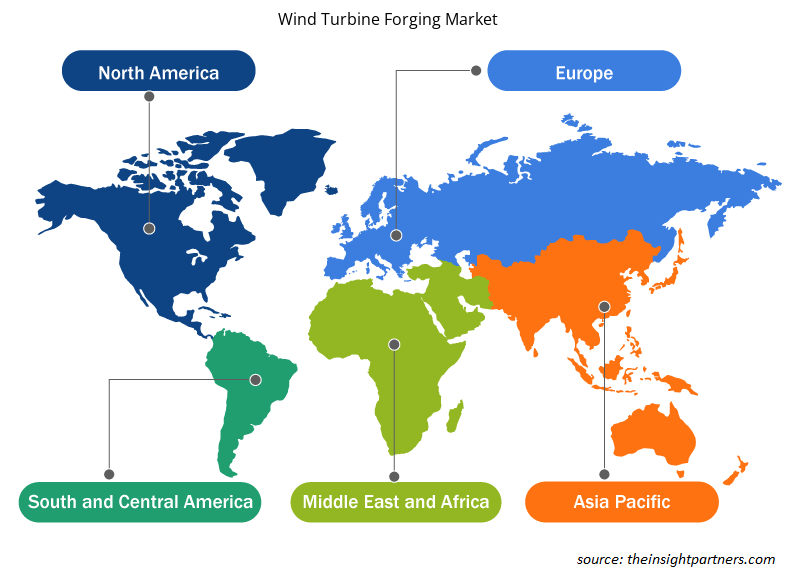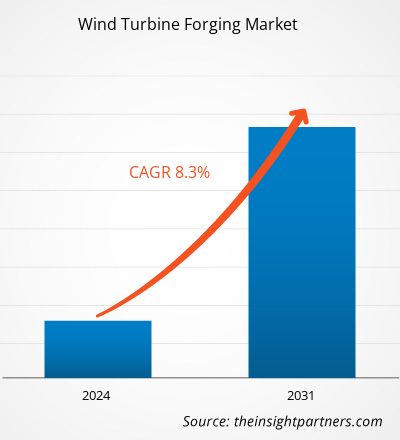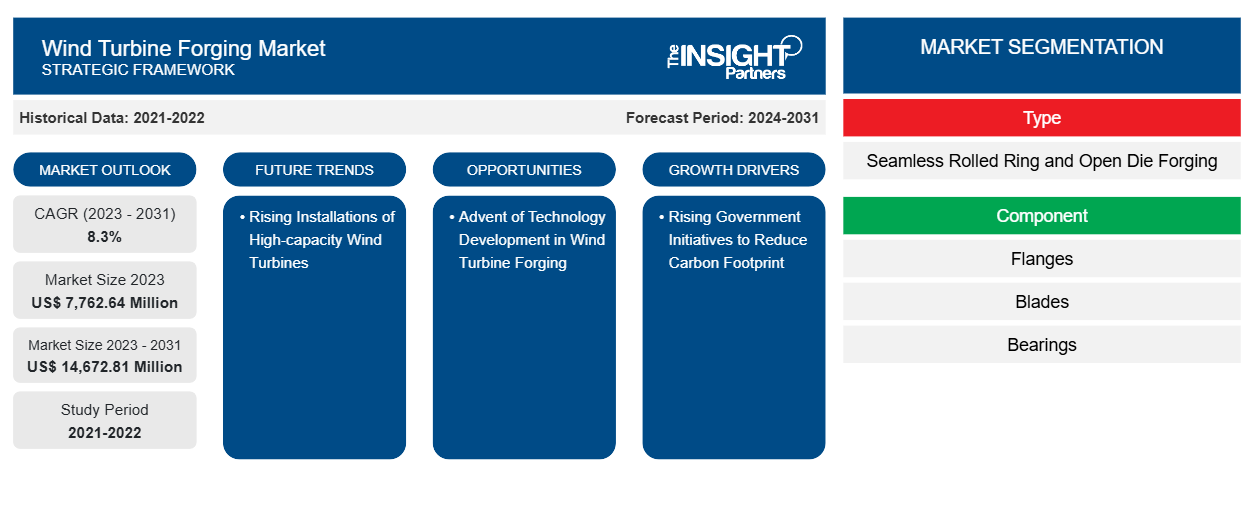Si prevede che la dimensione del mercato della forgiatura delle turbine eoliche raggiungerà i 14.672,81 milioni di dollari entro il 2031, rispetto ai 7.762,64 milioni di dollari del 2023. Si prevede che il mercato registrerà un CAGR dell'8,3% nel periodo 2023-2031. È probabile che l'avvento dello sviluppo tecnologico nel settore eolico rimanga una tendenza chiave nel mercato.
Analisi del mercato della forgiatura delle turbine eoliche
L'ecosistema del mercato della forgiatura delle turbine eoliche comprende Frisa ; Iraeta ; Ulma Forged Solutions; Celsa Nordic; Bharat Forge. Questi stakeholder includono fornitori di materie prime, produttori di componenti e utenti finali. La forgiatura delle turbine eoliche è una parte importante del sistema delle turbine eoliche. I fornitori di materie prime forniscono ai produttori di prodotti forgiati materiali come acciaio per alberi delle turbine eoliche o persino calcestruzzo per torri delle turbine eoliche. I produttori sviluppano quindi l'albero principale di una turbina eolica, forgiato in acciaio, che diventa temprato e rinvenuto nel processo di forgiatura. Le torri in acciaio tubolare sono prodotte in 20-30 metri con flange a ciascuna estremità. FRISA offre forgiature ad alte prestazioni per turbine eoliche per piattaforme di turbine eoliche. I produttori di componenti forniscono quindi i pezzi forgiati agli OEM nel settore dell'energia eolica. Le crescenti richieste per i processi di laminazione ad anello con diametri e sezioni trasversali fino a 3 metri e pale forgiate stanno spingendo il mercato della forgiatura delle turbine eoliche.
Panoramica del mercato della forgiatura delle turbine eoliche
I fornitori di forgiatura di turbine eoliche includono aziende come Scot Forge Company; Specialtyring ; Irizar Forge; Tongyu Heavy Industry Co., Ltd; e Bortome , che fornisce prodotti forgiati agli utenti finali nel settore dell'energia eolica. Queste aziende forniscono componenti essenziali per il settore delle energie rinnovabili e stanno costantemente espandendo il loro portafoglio prodotti e la loro base clienti. Si prevede che la crescente costruzione di parchi eolici e turbine onshore e offshore aumenterà la domanda per il mercato globale della forgiatura di turbine eoliche nei prossimi anni.
Personalizza questo report in base alle tue esigenze
Riceverai la personalizzazione gratuita di qualsiasi report, comprese parti di questo report, o analisi a livello nazionale, pacchetto dati Excel, oltre a usufruire di grandi offerte e sconti per start-up e università
-
Scopri le principali tendenze di mercato in questo rapporto.Questo campione GRATUITO includerà analisi di dati che spaziano dalle tendenze di mercato alle stime e alle previsioni.
Driver e opportunità del mercato della forgiatura delle turbine eoliche
Crescenti iniziative governative per ridurre l'impronta di carbonio a favore del mercato
Gli incoraggianti mandati e iniziative governative stanno supportando l'espansione del settore dell'energia pulita, che si prevede ridurrà l'impronta di carbonio a livello globale. Si prevede che la crescente attenzione del governo sulla definizione di obiettivi per mitigare le emissioni di carbonio dai settori industriale, residenziale e commerciale entro il 2030 guiderà la crescita del mercato della forgiatura di turbine eoliche in tutto il mondo. La crisi energetica si è interrotta a causa della guerra tra Russia e Ucraina. Tuttavia, la crisi energetica è positiva per il settore delle energie rinnovabili poiché paesi come Italia, Regno Unito e Paesi Bassi stanno spostando i loro investimenti e sforzi verso le energie rinnovabili, come l'installazione di energia eolica. L'invasione dell'Ucraina da parte della Russia ha accelerato gli investimenti nel settore delle energie rinnovabili a livello globale per ridurre la dipendenza dai combustibili fossili. I paesi hanno aggiornato l'obiettivo dell'energia verde per soddisfare la domanda di energia. Inoltre, la guerra tra Russia e Ucraina ha accelerato la crescita del settore delle energie rinnovabili nei paesi asiatici. La Corea del Sud e il Giappone avevano già investito nella tecnologia dell'idrogeno e la guerra tra Russia e Ucraina ha ulteriormente accelerato i loro investimenti nel settore delle energie rinnovabili. Per questo motivo, la domanda di soluzioni di forgiatura per turbine eoliche è aumentata con l'aumento del numero di installazioni di turbine eoliche a livello globale.
Avvento dello sviluppo tecnologico nella forgiatura delle turbine eoliche
L'ingegneria assistita da computer sta ottenendo una rapida implementazione nella forgiatura, un processo di produzione che produce la forma richiesta di un elemento impiegando un carico d'impatto sull'elemento metallico. L'utilizzo della tecnologia CAE nel settore della forgiatura ha ridotto sostanzialmente i tempi di consegna e gli errori durante la produzione del prodotto, rendendo così il processo più efficiente, il che si prevede offrirà elevate opportunità di crescita per il mercato.
Analisi della segmentazione del rapporto di mercato sulla forgiatura delle turbine eoliche
I segmenti chiave che hanno contribuito alla derivazione dell'analisi di mercato della forgiatura delle turbine eoliche sono tipologia e componente.
- In base al tipo, il mercato della forgiatura delle turbine eoliche è suddiviso in anelli laminati senza saldatura eforgiatura a matrice aperta. Il segmento della forgiatura a matrice aperta ha detenuto una quota di mercato maggiore nel 2023.
- Per applicazione, il mercato è segmentato in flange, lame, cuscinetti, ingranaggi, alberi e altri. Il segmento flange ha detenuto una quota significativa del mercato nel 2023.
Analisi della quota di mercato della forgiatura delle turbine eoliche per area geografica
L'ambito geografico del rapporto di mercato sulla forgiatura di turbine eoliche è suddiviso principalmente in cinque regioni: Nord America, Asia Pacifico, Europa, Medio Oriente e Africa, e Sud e Centro America.
L'Asia Pacifica è leader di mercato. L'Asia Pacifica è una regione densamente popolata in tutto il mondo, con una maggiore domanda di energia. La regione Asia Pacifica è estremamente dipendente dai combustibili fossili per la generazione di energia e, per ridurre la dipendenza, paesi come Cina, India, Giappone e Australia stanno investendo fortemente in progetti di energia rinnovabile. Oltre a questo, i prezzi alle stelle del petrolio greggio nelle regioni a causa della guerra in Russia e Ucraina hanno ulteriormente intensificato la crisi energetica nella regione. Pertanto, la crisi energetica complessiva nella regione asiatica ha spinto in modo significativo gli investimenti verso progetti di energia eolica e solare. Infatti, la Cina è il più grande produttore e detiene anche la più grande installazione di progetti di energia eolica in tutto il mondo. Allo stesso modo, anche India e Giappone stanno contribuendo in modo significativo allo sviluppo del settore delle energie rinnovabili . Pertanto, la crisi energetica ha un impatto positivo significativo sull'industria della forgiatura delle turbine eoliche, poiché con l'aumento dell'installazione di turbine eoliche, aumenterà anche la domanda di componenti forgiati.
Approfondimenti regionali sul mercato della forgiatura delle turbine eoliche
Le tendenze regionali e i fattori che influenzano il mercato della forgiatura delle turbine eoliche durante il periodo di previsione sono stati ampiamente spiegati dagli analisti di Insight Partners. Questa sezione discute anche i segmenti e la geografia del mercato della forgiatura delle turbine eoliche in Nord America, Europa, Asia Pacifico, Medio Oriente e Africa e America meridionale e centrale.

- Ottieni i dati specifici regionali per il mercato della forgiatura delle turbine eoliche
Ambito del rapporto di mercato sulla forgiatura delle turbine eoliche
| Attributo del report | Dettagli |
|---|---|
| Dimensioni del mercato nel 2023 | 7.762,64 milioni di dollari USA |
| Dimensioni del mercato entro il 2031 | 14.672,81 milioni di dollari USA |
| CAGR globale (2023-2031) | 8,3% |
| Dati storici | 2021-2022 |
| Periodo di previsione | 2024-2031 |
| Segmenti coperti |
Per tipo
|
| Regioni e Paesi coperti |
America del Nord
|
| Leader di mercato e profili aziendali chiave |
|
Densità degli attori del mercato: comprendere il suo impatto sulle dinamiche aziendali
Il mercato della forgiatura delle turbine eoliche sta crescendo rapidamente, spinto dalla crescente domanda degli utenti finali dovuta a fattori quali l'evoluzione delle preferenze dei consumatori, i progressi tecnologici e una maggiore consapevolezza dei vantaggi del prodotto. Con l'aumento della domanda, le aziende stanno ampliando le loro offerte, innovando per soddisfare le esigenze dei consumatori e capitalizzando sulle tendenze emergenti, il che alimenta ulteriormente la crescita del mercato.
La densità degli operatori di mercato si riferisce alla distribuzione di aziende o società che operano in un particolare mercato o settore. Indica quanti concorrenti (operatori di mercato) sono presenti in un dato spazio di mercato in relazione alle sue dimensioni o al valore di mercato totale.
Le principali aziende che operano nel mercato della forgiatura delle turbine eoliche sono:
- Società di forgiatura scozzese
- Frisa Industrias SA di CV
- Iraeta Energy Equipment Co Ltd
- ULMA Forja S Coop
- Celsa Armeringsstal AS
- Azienda Bharat Forge Ltd
Disclaimer : le aziende elencate sopra non sono classificate secondo un ordine particolare.

- Ottieni una panoramica dei principali attori del mercato della forgiatura delle turbine eoliche
Notizie e sviluppi recenti sul mercato della forgiatura delle turbine eoliche
Il mercato della forgiatura delle turbine eoliche viene valutato raccogliendo dati qualitativi e quantitativi dopo la ricerca primaria e secondaria, che include importanti pubblicazioni aziendali, dati associativi e database. Di seguito sono elencati alcuni degli sviluppi nel mercato della forgiatura delle turbine eoliche:
- Le flange del progetto eolico offshore Moray West sono state spedite con successo da Iraeta. Si è capito che le flange saranno utilizzate per il progetto eolico offshore Moray West in Scozia, che utilizza turbine eoliche SGRE da 14 MW. Iraeta ha intrapreso tutti i 62 set di flange TP e 30 set di MPS per il progetto, per un totale di 152 flange. (Fonte: Iraeta Energy Equipment Co Ltd, comunicato stampa, novembre 2022)
- Bharat Forge avvia la fornitura di forgiati utilizzando acciaio verde , rafforzando l'impegno dell'azienda nel ridurre l'impronta di carbonio. (Fonte: Bharat Forge, comunicato stampa, dicembre 2022)
Copertura e risultati del rapporto sul mercato della forgiatura delle turbine eoliche
Il rapporto "Dimensioni e previsioni del mercato della forgiatura delle turbine eoliche (2021-2031)" fornisce un'analisi dettagliata del mercato che copre le seguenti aree:
- Dimensioni e previsioni del mercato della forgiatura di turbine eoliche a livello globale, regionale e nazionale per tutti i principali segmenti di mercato coperti dall'ambito
- Le turbine eoliche forgiano le tendenze del mercato e le dinamiche del mercato, come i driver, i vincoli e le opportunità chiave
- Analisi PEST e SWOT dettagliate
- Analisi del mercato della forgiatura delle turbine eoliche che copre le principali tendenze del mercato, il quadro globale e regionale, i principali attori, le normative e i recenti sviluppi del mercato
- Analisi del panorama industriale e della concorrenza che copre la concentrazione del mercato, l'analisi della mappa di calore, i principali attori e gli sviluppi recenti per il mercato della forgiatura delle turbine eoliche
- Profili aziendali dettagliati
- Analisi storica (2 anni), anno base, previsione (7 anni) con CAGR
- Analisi PEST e SWOT
- Valore/volume delle dimensioni del mercato - Globale, Regionale, Nazionale
- Industria e panorama competitivo
- Set di dati Excel
Report recenti
Rapporti correlati
Testimonianze
Motivo dell'acquisto
- Processo decisionale informato
- Comprensione delle dinamiche di mercato
- Analisi competitiva
- Analisi dei clienti
- Previsioni di mercato
- Mitigazione del rischio
- Pianificazione strategica
- Giustificazione degli investimenti
- Identificazione dei mercati emergenti
- Miglioramento delle strategie di marketing
- Aumento dell'efficienza operativa
- Allineamento alle tendenze normative























 Ottieni un campione gratuito per - Mercato della forgiatura delle turbine eoliche
Ottieni un campione gratuito per - Mercato della forgiatura delle turbine eoliche